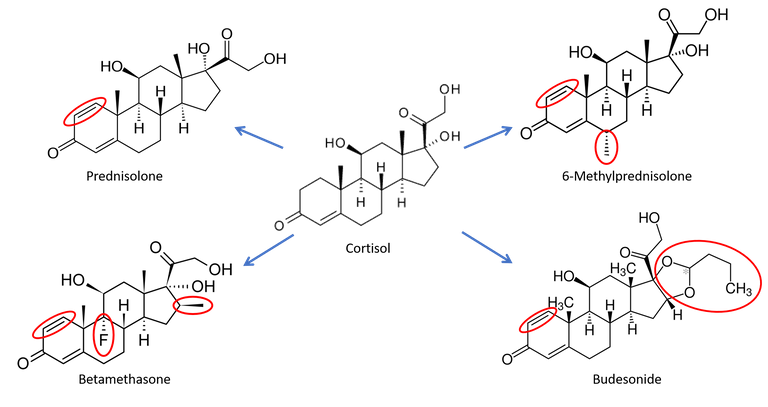After a small illness-related break, I'm back again with an exciting topic:
The Power of API Tuning
Many of the active pharmaceutical ingredients (short: APIs) and their physiological effects used in modern medication have been discovered by accident. In many cases these are substances which have been isolated first from plants, fungi or bacteria.
These substances are medically relevant because they interact with the body, hence they show physiological effects. Such interactions can be exploited to treat physiological incapabilities and diseases. Sometimes the interactions of the substances with the body are not too specific and the patient not only experiences desired effects but also others: side effects.

Image Source
There are various approaches to minimize side effects, e.g.
Efficient Drug Delivery:
If the drug is administered in such a way that the API reaches the site of action efficiently (e.g. direct injection, gastro-resistant tablet,...) a smaller total dosage of API may give the same therapeutic effect as large ones. This goes hand in hand with a reduction of systemic side effects.Tuning of the API for easy excretion:
Even with targeted local application of drugs, in many cases, absorption into the organism can not be prevented. In order to preclude extensive systemic interactions, an efficient excretion mechanism is necessary.Selectivity Tuning of the API:
In this case, the chemical structure of the active ingredient is altered in order to increase preferential and strong interactions with the desired receptors only, or to allow an enhanced directed transport into the tissue of interest.
First and Second Generation APIs
First-generation substances are those that have been discovered and approved first. Second-generation drugs are structurally often based on first-generation drugs. They are often (not always!) better compatible and more efficient, since API tuning has specifically been done to gain benefits of this type. - But how is this done?
In principle the chemical structure is altered either by a rational or a statistical approach. For example, a rational approach is possible if the 3D-structure and the precise interactions between the API and the involved receptor are known very well. This allows to change the design of the drug in a rational way. Small modifications (e.g. side chains) may change important properties, e.g. a more efficient degradation and excretion.
The variants obtained by the changes are retested and in some fortunate cases show improvements in one or more of the mentioned properties.
Examples
In order to illustrate the dicussed topic, the well-known and powerful group of corticosteroids shall be utilized:

All changes are highlighted in red. - Ref. 2
Cortisol was discovered in 1937 and plays a key role as an endogenous hormone in a variety of inflammatory and metabolic processes as also in the water balance. On the one hand this makes it a very potent drug candidate, but on the other it is also quite unspecific and the intake is accompanied by some serious side effects.
Therefore, the API has been modified in different ways to allow better treatment options:
Prednisolone:
4-times more anti-inflammatory, mineral balance hardly affected6-Methylprednisolone:
5-times more anti-inflammatory, mineral balance hardly affectedBudesonide:
highly effective, 90% degraded after the first liver passageBetamethasone:
more stable form, gives higher active concentration, which allows the use of smaller dosages; prolonged use may cause accumulation and then again gives severe side effects
mountain.phil28
References:
- T. Andus, Kortikosteroid-Therapie, 2010, 17th Edition
- Compound images taken from Wikipedia
- Sumeet Gupta, Indian J. Psychiatry, 2010, 52(1), 77.
Great post and great to see someone talking about pharma that knows what they're on about! I'm giving you a follow :)
Thx I appreciate your interest. 🙂
Hi, very nice to see your post!Thanks for you share!
what a great subject! well written and useful info :D
Hm i dont have my history all sorted, buut as far as i know , the side effects on cortisol are still massive...
Your pictures helps you text well :D
side topic is also, meds can have diffrent effect depending on other sicknesses and actually also depending on that specific human
Thanks for the compliment. ;)
Yes. You are right, the side effects still can be quite extensive, especially if we talk about such a powerful substance category like corticosteriods. Nonetheless the tuning helps to reduce them significantly!
As always in medicine: We deal with human individuals. Not all of us do have the same physiological capabilities, hence there is always a individual factor involved. This is also the reason for the circumstance, that many patients who are treated with powerful medication, like those presented, do have to get tested regularly (e.g. blood test,...), to see if there are any problems coming up for the individual.
Best,
mountain.phil28
ha ha ;) of course i am right <jupp humble needed :P ;) ohh dont get me wrong, they all help , il guess, dont over think this, please! with the amount of time, & differnt corticosides we shooould have gotten aways from the bigger most dameding side effects..
Oh im loving tuning :D ha ha
Yes we do have blood and test up & down, BUT !!!! that still will make us miss individuals preclivetys to serten substances :) Im getting to them ,we canT scan for...
Tests can be done in advance too (allowing some kind of statistical prediction), but the tests I mentioned in my last comment are done during treatment (so while those people are taking the drugs). This allows us to see and react to individual cases of incompatibility. This can indeed be reliably scanned.